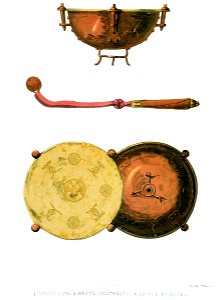— tulumbas. B — the top of the tulumbas. B — the bottom. G — the voshchaga. The use of tulumbas, like small kettledrums, according to the description of raphael barberini in 1563, was as follows: “when the tsar goes out for a walk around the city, you often see him dressed simply, in some colored caftan without gold; he takes with him only a few foot servants, and since there are a lot of people on all the streets there (in moscow), sometimes, being in the crowd, he carries with him at the bow of his saddle a small drum, like the one the moors have on their horses; and when he hits it with the handle of a whip, which all riders usually have, the people immediately scatter in different directions; however, i happened to see such an instrument with his sons, and with other noble boyars. ” in the inventory of the treasury of mikhail fedorovich in 1640, among the iron, copper and damask tulumbas, there are "two iron tulumbas trimmed with gold, with striped silk braid around the edges, green silk braid for tying, scarlet velvet cushion from the saddle; the tsarevich of yurgen (georgia) bowed to the tsar in 1634. " "the copper tulumbas is gilded, the edges are lined with black velvet, covered with black khoz, the edging and grass are khoz-grain. Sent as a gift to the tsar by shah abbas of kizylbash, in 1627. " the tulumbas kept in the armoury chamber, depicted in drawing no. 132, corresponds to the following from the inventory book of 1687: “the tulumbas is the same, on it is an eagle, under the top is worm-eaten velvet. And according to the current inventory of 1706, that tulumbas is similar, and upon inspection, that tulumbas has an eagle painted on the top of the lining; the price of that tulumbas is twenty-five altyns. ” rich tulumbas, according to the inventory of 1687, were silver, gilded, decorated with precious stones: “a silver, white, smooth tulumbas, on it are six gilded silver cloaks, with stones of wine and turquoise; under the top is green velvet, with silver nails. It weighs four pounds and a half pound; the price of that tulumbas is seven rubles per pound, a total of twenty-four rubles, sixteen altyns, four dengi. " the whips with balls on the end, which were used to hit the tulumbas, were called voshchags. The inventory of 1687 states: "six voshchags that hit the tulumbas are covered with worm-like velvet. Seven voshchags are embroidered with gold and silver, the handles are covered with worm-like velvet, the handle of the seventh is painted. ". Date: before 1853.
Loading...
